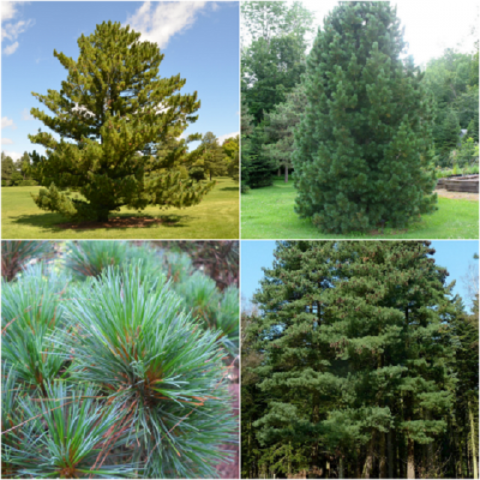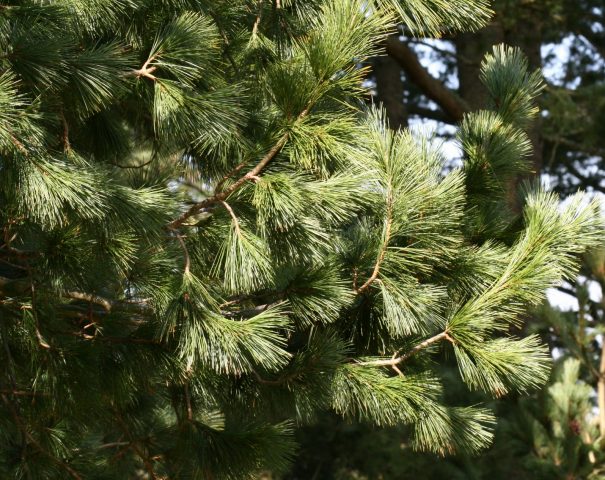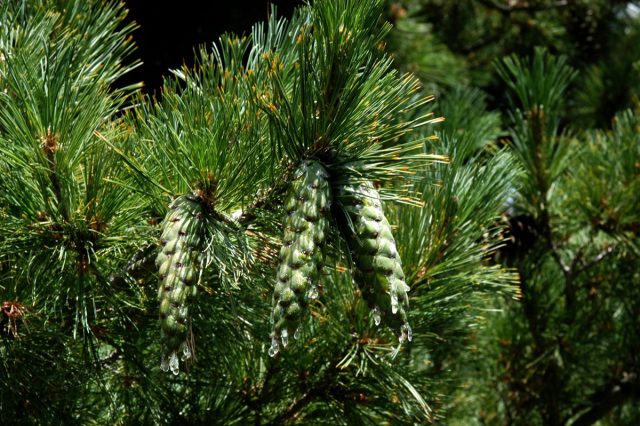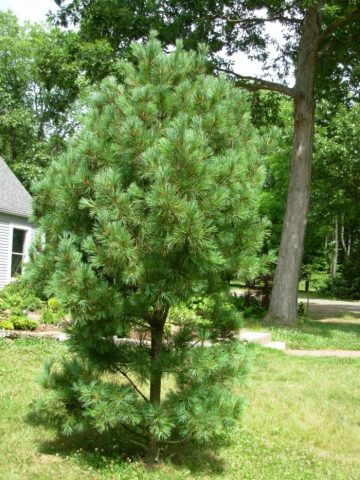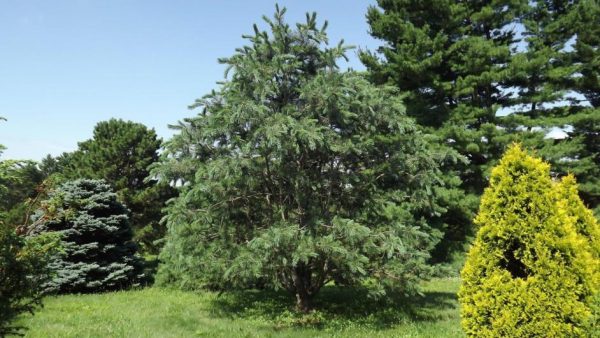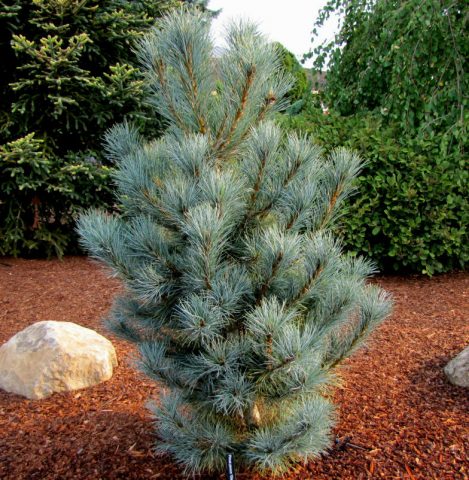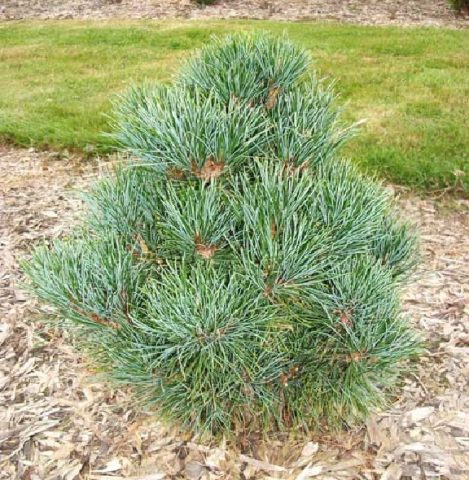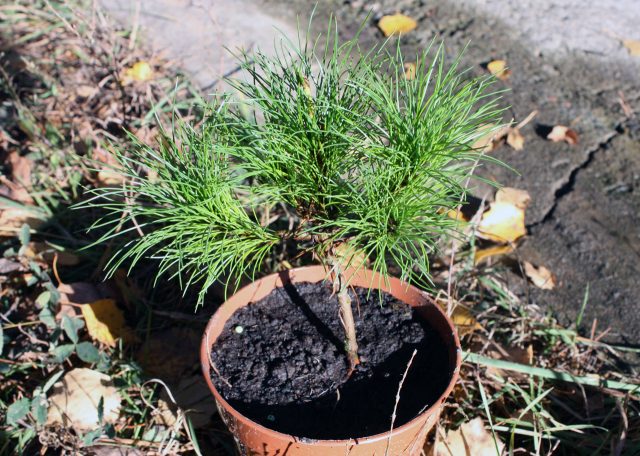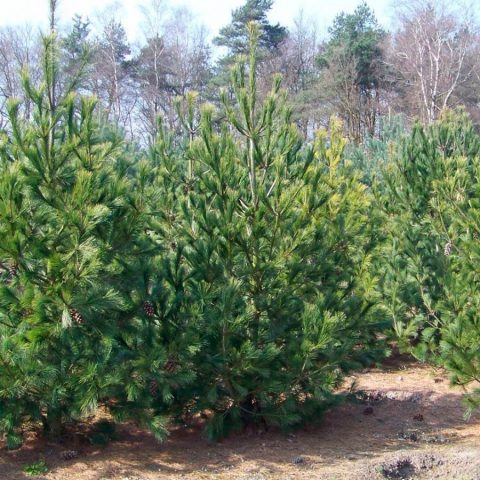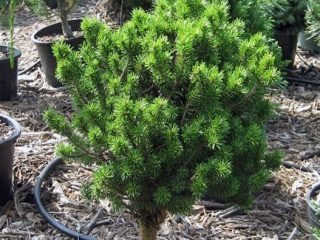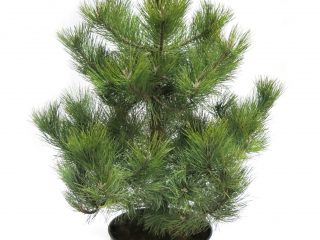Content
Rumelian pine is a beautiful, fast-growing crop often found in southern parks and gardens. For the larger territory of Russia, it is not suitable - it is too thermophilic, and it is unrealistic to cover it in winter - the tree is rapidly gaining height. But there is already one variety that can grow in the Moscow region, perhaps over time there will be more of them.
Description of Rumelian pine
Rumelian pine (Pinus peuce) has other officially recognized names, under which the species can be found in reference books - Balkan and Macedonian. The culture belongs to the genus Pine (Pinus), the Pine family (Pinaceae), distributed in the mountains of the Balkan Peninsula at an altitude of 600 to 2200 m above sea level. Naturalized in the east of Finland.
Rumelian pine grows rapidly, adding more than 30 cm per year, the average height of a fully mature tree in North Macedonia, Greece, Albania, Yugoslavia is 20 m.In Bulgaria, the culture reaches a maximum size of 35 m (several specimens of 40 m have been recorded). The diameter of the trunk, measured at chest level, is from 50 cm to 1.5 m.
The Rumelian pine forms a more or less symmetrical crown with oval or pyramidal outlines. Rarely it narrows to columnar. In natural conditions, at an altitude of 1800 m above sea level, you can find multi-stem trees, which some sources pass off as a bush, which culture is not.
In fact, this is just the "work" of squirrels and other forest dwellers, storing cones for the winter, and then forgetting where they were hidden. So a kind of coniferous "hedgehog" rises. But if in other species usually, in the end, one seedling remains, in the rarest cases - two, then for the Rumelian pine such an impromptu "bouquet" of several trunks is common. A bush of several trees growing close to each other with a height of up to 20-40 m is somehow difficult to name.
Branches on the Rumelian pine begin almost from the surface of the soil, the branches are bare, thick, gentle. In the lower part of the crown of an adult tree they grow horizontally, at the top - vertically. The shoots located in the middle of the trunk first run parallel to the ground, then lift up.
Young growth is green, becoming silvery-gray by the end of the season. On mature branches, the bark darkens, but remains fairly smooth. Only on really old trees does it crack and turn brown.
Needles 7-10 cm long are collected in bunches of 5 pieces, live from 2 to 5 years. The needles are green, shiny, pleasant to the touch.
Cones are numerous, grow in 1-4 pieces, hanging or on short cuttings, ripen 17-18 months after pollination, usually in October. Juveniles are very beautiful, green, narrow, often curved, resinous. Mature ones change color to light brown, immediately open and lose their gray-brown seeds. The size of Rumelian pine cones is from 9 to 18 cm.
Rumelian pine varieties
To date, not many varieties of Rumelian pine have been created. Perhaps this is due to the fact that the culture is already very beautiful; species trees are planted in parks or large gardens. Low frost resistance is also important, which limits the spread of Rumelian pine.
Caesarini
Pinus peuce Cesarini is intended for frost resistance zone 5. The variety is a dwarf, slow-growing tree with a wide-pyramidal crown and soft gray-green needles.
At 10 years old, the Rumelian Caesarini pine reaches a height of 1 m with a crown diameter of 60 cm.Seasonal growth is 5-10 cm.
Gedello
Pinus peuce Jeddeloh is a new, fast-growing variety that appeared at the beginning of the 21st century, adding 30-45 cm annually.At a young age, the Rumelian Dzhedello pine forms a rather narrow crown, the plant height is 3-5 m, the width is 1.3 m.
The old tree increases significantly in volume due to the fact that the lower branches pass into the horizontal plane. This significantly changes the shape of the crown, it becomes like a wide cone. The needles are blue-green, long, dense.
Pacific Blue
The new Pinus peuce Pacific Blue winters in zone 4 and can be grown in most of Russia. This Rumelian pine gives an annual growth of more than 30 cm. An adult tree reaches a height of 6 m with a crown diameter of 5 m. A young plant, in which the lower branches did not have time to go into the horizontal plane, is much narrower. The needles are thin, bright blue.
Arnold Dwarf
The name of the Pinus peuce Arnold Dwarf cultivar is translated as Arnold's Dwarf. This is a dwarf plant, reaching 1.5 m by the age of 10. It grows slowly, adding no more than 15 cm per season. The crown is broad-pyramidal, the needles are thin, bluish-green. Can grow in partial shade, winters in zone 5.
Planting and caring for the Rumelian pine
The culture is hardy, with the exception of low winter hardiness. Prefers to grow on moderately fertile soils, tolerates urban conditions satisfactorily. Rumelian pine grows best in full sun, but will tolerate light partial shade.
Seedling and planting plot preparation
Rumelian pine is not very hardy, and can only grow in regions with a warm climate. It is planted in autumn and all winter, in spring - only container plants.
This species will grow poorly on excessively poor or fertile soils - the Rumelian or Macedonian pine loves the golden mean. When preparing the substrate, sand and sod land must be added to black soil. If there is gravel or crushed stone on the site, stones are used not only for drainage, but also mixed into the soil mixture. Too poor improve the same sod land and leaf humus. Clay and lime are added if necessary.
The size of the planting pit depends on the age of the seedling. The depth should be such as to accommodate 20 cm of drainage and the root of the Rumelian pine, the width should not be less than 1.5 times the diameter of the earthen coma.
Drainage is laid in the dug planting hole, covered with a substrate by 2/3, and filled with water. It should settle for at least 2 weeks.
It is better to buy a small seedling of Rumelian pine in a container, large-sized trees can be taken with an earthen lump sheathed with burlap. The needles should be fresh and smell good, the branches should be flexible, the potted substrate or burlap should be moderately moist.
Landing rules
Rumelian pine is planted in the same way as other conifers. Prepare a pit, fill up the drainage and most of the substrate, fill it with water, let it settle for at least 14 days. The operation itself is carried out in the following sequence:
- Part of the soil is taken out of the planting pit and set aside.
- The Rumelian pine is placed in the center. The root collar should be level with the edge of the pit.
- The substrate is poured gradually, constantly compacting.
- Water so that the water stops absorbing and stands in the near-stem circle.
- After some time, the space under the tree is covered with mulch with a layer of at least 5 cm.
Watering and feeding
Unlike other pines, Rumelian is hygrophilous and requires regular watering throughout its life. This does not mean that the tree needs to be drowned in water or even the top layer of the soil should not be allowed to dry out.
In the spring, in the absence of rain, the pine is watered once a month, in hot summer - twice as often. In the fall, moisture charging is required.
Top dressing is carried out twice a season:
- in spring, complex fertilizer with a high nitrogen content;
- in early autumn - phosphorus and potassium.
Foliar dressing is useful for Rumelian pine, allowing the tree to receive trace elements and other substances that are poorly absorbed through the root. If the culture is grown in difficult conditions for the culture, it is recommended to add epin and zircon alternately to the balloon.
Mulching and loosening
The soil under the Rumelian pine should be loosened in the year of planting and part of the next season. When it becomes clear that rooting was successful, it is stopped, limiting itself to mulching.
For this purpose, it is better to use pine bark that has been treated against pests and diseases, or completely rotted sawdust, chips, or other wood processing waste. Nutshells, dyed marble chips, or other similar materials may decorate the site, but damage the plant.
Pruning
The Rumelian pine does not need formative pruning. But to make the crown thicker, and limit the growth of a species tree or tall varieties, the growth can be pinched by 1/3 or 1/2. This is done in the spring, when the young branches have already stopped their intensive growth, but the needles have not yet separated from the shoot. There is no need to cover up the cut points - the pine secretes resin, which itself will disinfect and cover the wound surface.
During sanitary pruning, dry, broken and diseased branches are removed.
Preparing for winter
Rumelian pine winters without shelter in zone 5. It should be protected from the cold only in the year of planting, covering it with spruce branches or white non-woven material. In subsequent seasons, they are limited to soil mulching.
Reproduction
Pine trees are not propagated by cuttings. They are bred by grafting and sowing seeds. Lovers can independently propagate the species pine.
Only a small proportion of seedlings of varieties, if they are not obtained from a witch's broom, inherit maternal traits. Nurseries carry out culling from the first year of the pine's life. Amateurs do not have such skills, they can grow anything - from a species plant to a new variety, which experts would immediately separate from the bulk of plants.
Seeds can be sown without preliminary preparation, but it is better to stratify for 2-3 months, keeping them at a temperature of 2-7 ° C.
Diseases and pests
Rumelian pine rarely gets sick, even blister rust - the scourge of other members of the genus, this species usually bypasses.
Of the insects causing harm to culture, it is necessary to highlight:
- mealybug;
- common pine shield;
- pine scoop;
- various types of aphids.
Conclusion
Rumelian pine is very beautiful, its soft shiny needles are sometimes compared to silk. This culture differs from other species by increased requirements for soil moisture and resistance to resin crayfish.
